This scout report is a tactical analysis of Kalidou Koulibaly for the season 2019/20. It is an analysis of his style of play, and his role in the tactics deployed by Napoli. It further aims to arrive at his importance in the Napoli line-up.
Kalidou Koulibaly has been at Napoli for six full seasons now, arriving from Genk ahead of the 2014-15 season. In the six years with Napoli, he has managed to cement his place as one of the most sought after centre-backs in world football. There hasn’t been a transfer window in the past few seasons, without him being linked to the biggest clubs in Europe. The recent windows have been no different, with Premier League clubs such as Manchester United, Manchester City, Liverpool and Chelsea, all being linked as possible destinations. This season, however, hadn’t been Napoli’s best, for more reasons than one. The on-going dispute with the board could have possibly pulled down performance levels of the players as they finished seventh in the league. Their worst finish in the past eleven seasons! They did, however, manage to win the Coppa Italia and save themselves some blushes.
Napoli’s defence has been a strong contributor to the team’s fortunes in recent years, and one of their main men has been Koulibaly. The analysis aims to understand his contribution to the team’s play, both defensively and in attack, and thereby evaluate his importance to the side. The tactical analysis is based on all of the Serie A games he’s played in season 2019/20.
Role in the line-up
Kalidou Koulibaly plays as a central defender in the Napoli side. Koulibaly prefers the left-sided central defender role as a part of a back four, and has played over 90% all of his minutes in that position – as a left central defender. The below starting line-ups from the games Udinese vs Napoli and Napoli vs Roma, demonstrating his preference to play on the left in a back four.
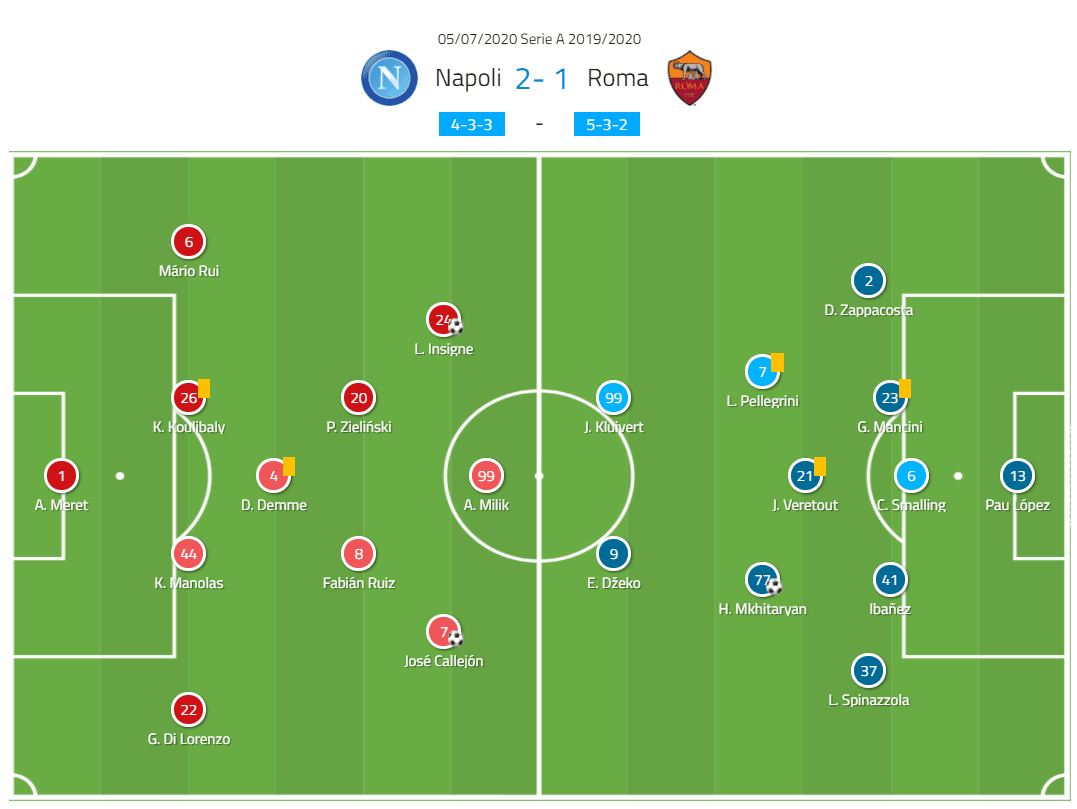
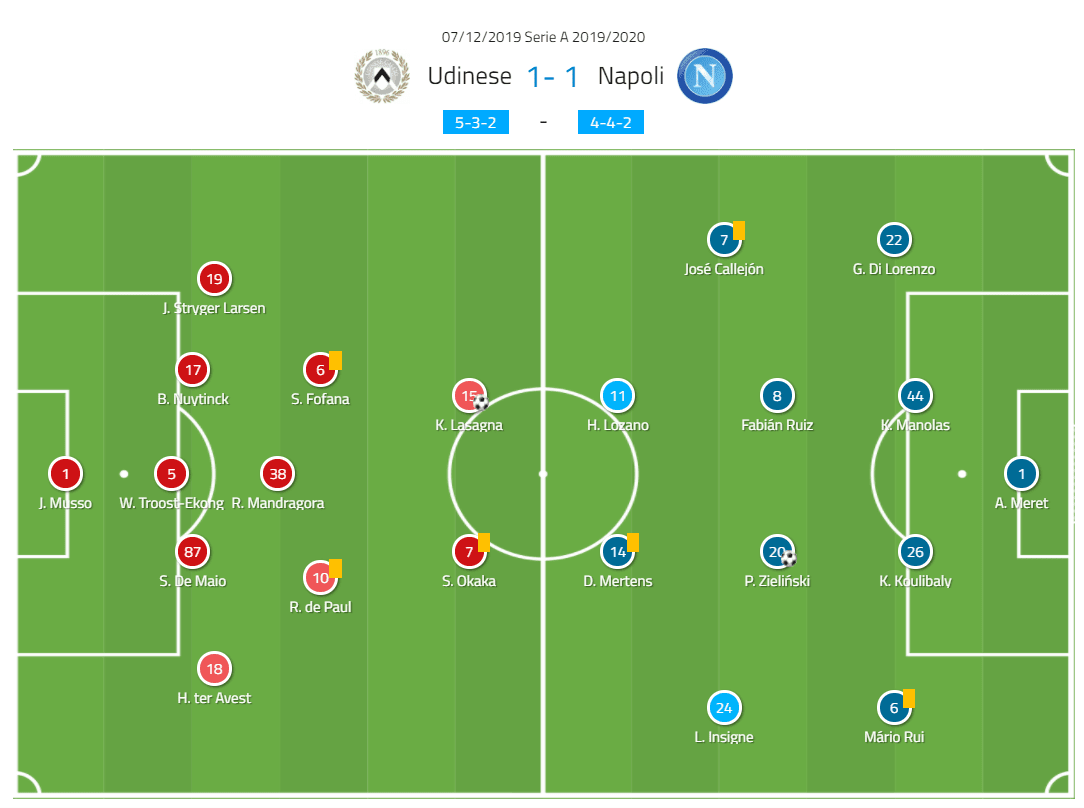
Koulibaly starts as the left central defender but has a strong right foot, which broadens his angle to visualise and make passes. The below heat-map indicates Koulibaly’s presence on the pitch.

Defensive Duties
As mentioned earlier in the scout report, this tactical analysis aims to understand the role Koulibaly plays in the defensive & attacking halves of the pitch for Napoli. The analysis first looks at Koulibaly’s defensive ability, to understand which we look at two key attributes: effectiveness in duels and positional awareness. The effectiveness in duels considers two kinds of duels: defensive duels and aerial duels. A defensive duel, is when Koulibaly was involved in a duel with an opponent player who was in possession of the ball at the time of the duel. An aerial duel is the same as a defensive duel, except when the players are aerial. The analysis of the duels takes two paths: first, the number of aerial and defensive duels that the player has been involved in indicating the defensive intent; and second, the number of aerial and defensive duels the player wins, indicating effectiveness in duels.
There are 63 central defenders who have played more than 1350 minutes in the Serie A, (approximately 15 games). In total, there are twice as many, but we consider only 63 for the analysis in this scout report, to ensure consistent and quality findings. Among these 63 central defenders, Kalidou Koulibaly is 35th on the list of players sorted by defensive duels involved in per 90. Below is the list.
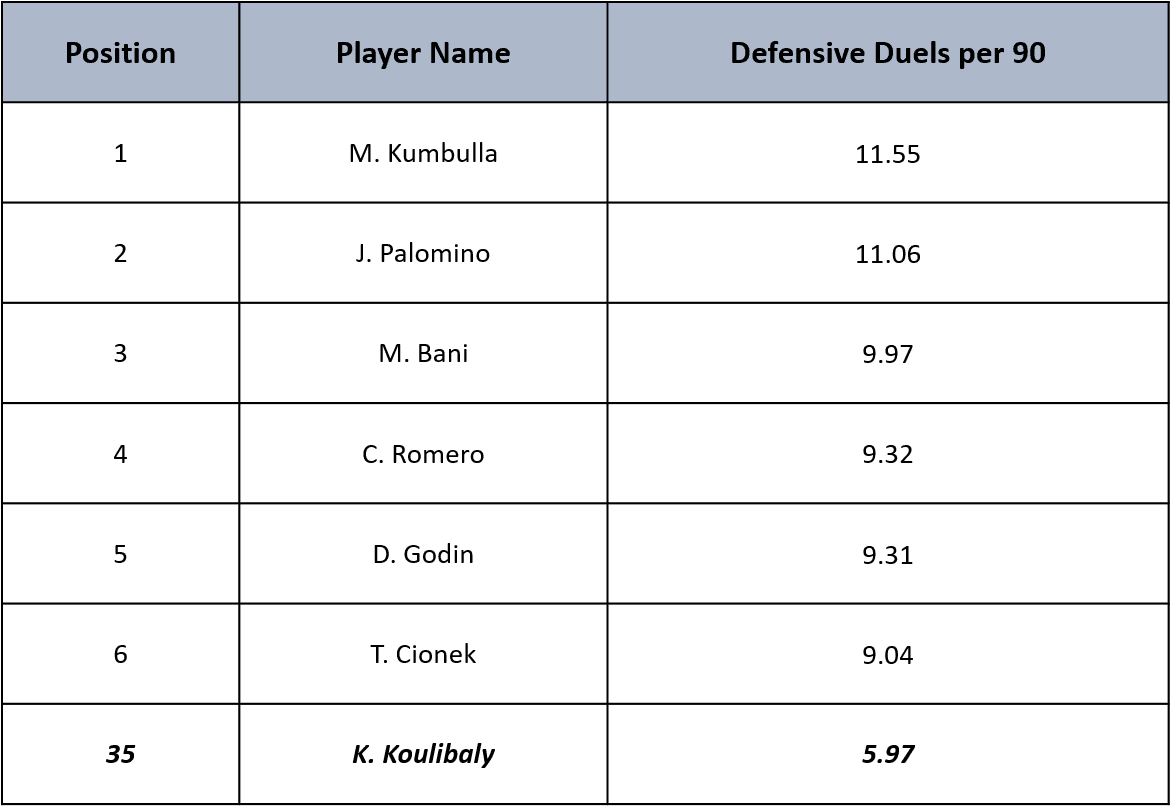
Even in terms of aerial duels, Koulibaly doesn’t feature very well. He stands 27th on the list of players sorted by aerial duels per 90. Below is the list.
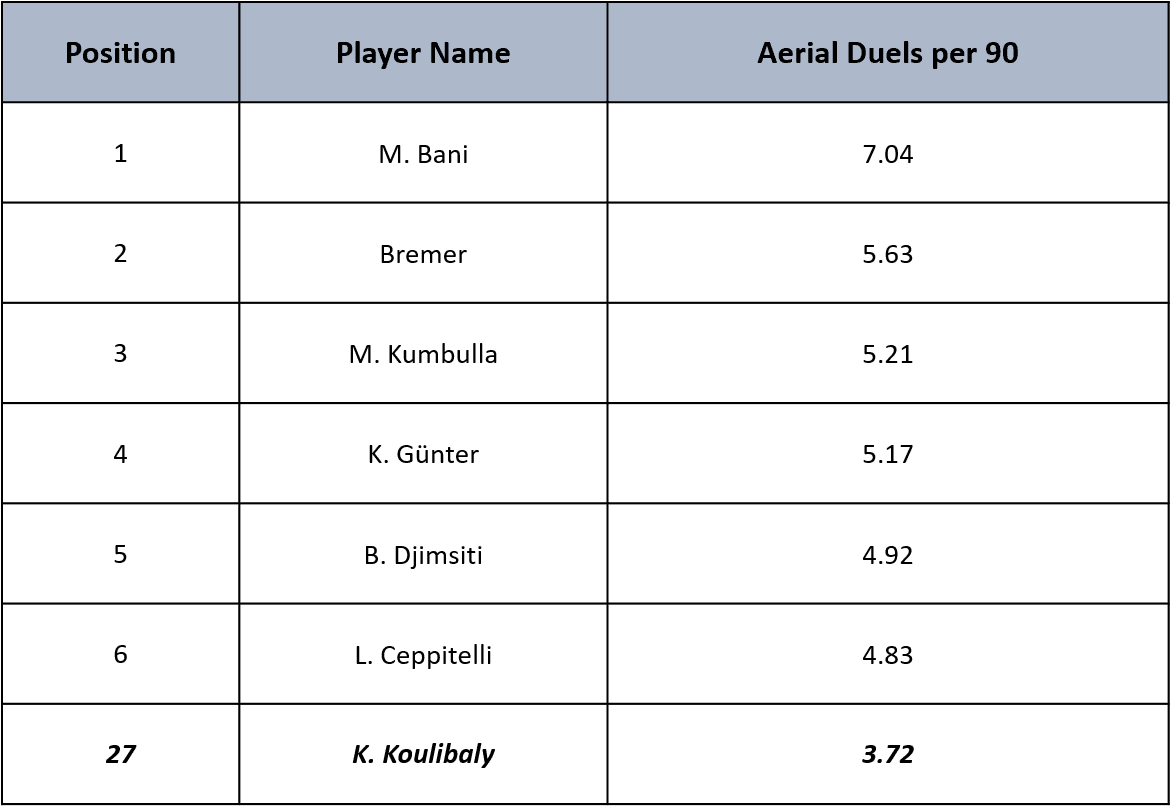
The above data indicates that Koulibaly does lack a certain defensive intent, as his number of duels involved per 90 are way lesser than most on the list. However, intent is only half the picture. The other half, is the effectiveness in those duels – i.e. if the duels are won or lost. For this analysis, we plot a scatter chart between the percentage of aerial duels won and the percentage of defensive duels won.
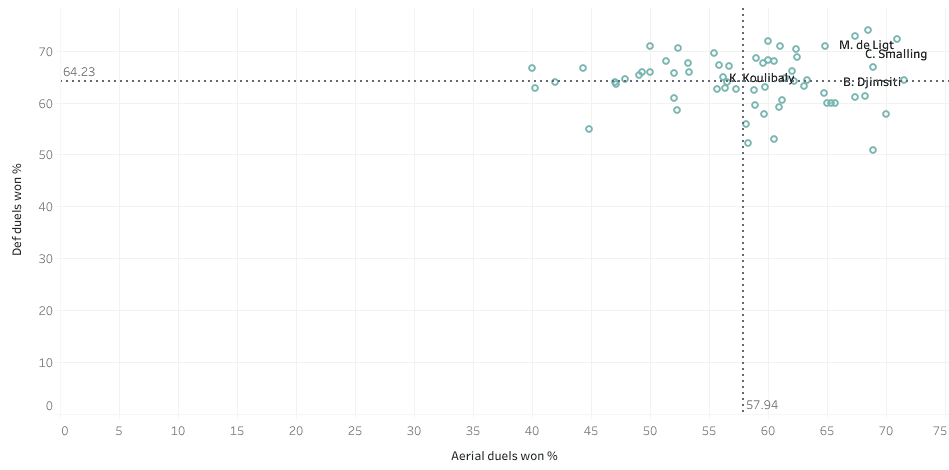
Matthijs De Ligt, Chris Smalling and Cristián Zapata, are the best in terms of their ability to win duels. Koulibaly, fares poorly in effectiveness in duels. He wins only 59% of his aerial duels and 67% of his defensive duels, as compared to the best aerial stats (Smalling wins 71%) and defensive stats (De Ligt wins 74%).
The tactical analysis, in order to understand Koulibaly’s defensive play better, further takes a look at his positional awareness. For this analysis, we consider possession adjusted-interceptions per 90 (PAdj Interceptions), and shots blocked per 90. Interceptions are useful in determining how good a player is at reading the game and anticipating the next move. Cutting off a passing lane by good positional awareness and intercepting a pass helps breakdown play and start a counter-attack. Shots blocked requires a combination of fine positional awareness and a willingness to put their body in the line for sake of their team. To study the same, we plot a scatter chart with the two metrics on each axis.
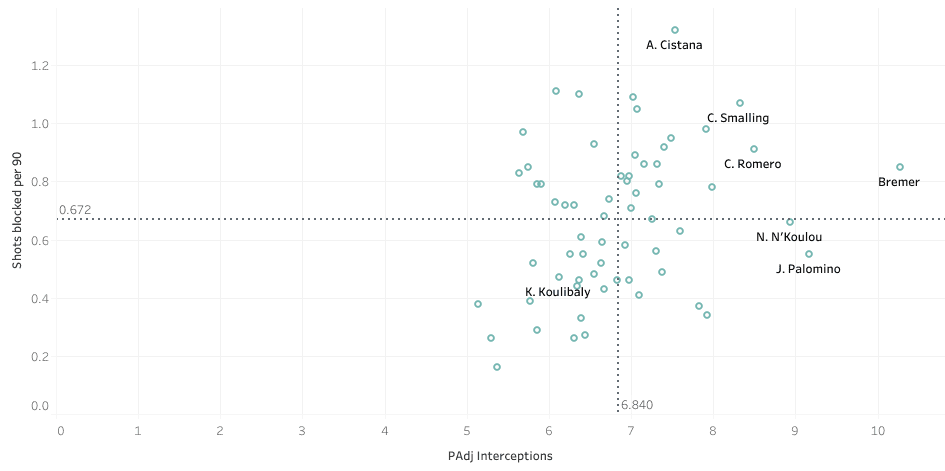
Bremer, Chris Smalling, Andrea Cistana and Cristian Romero are some of the best performing centre-backs in terms of positional awareness. In terms of interceptions per 90, Koulibaly records 6.12 as compared to Bremer’s metric best of 10.27. In terms of shots blocked per 90, Cistana leads the pack with 1.32 blocks per 90, with Koulibaly recording only 0.47 per 90.
If defensive ability was the sole criterion for selection, then the analysis indicates that Koulibaly would be detrimental to Napoli’s tactics and play. However, today’s game requires a central defender to not just defend but also be able to contribute to the build-up play and attacks. Therefore, for a more thorough analysis, the scout report aims to understand further aspects of Koulibaly’s game.
Ball Progression
The evolved game tactics often see centre-backs play the ball out from the back, moving the ball forward and contributing to the build-up play almost like a defensive midfielder. The game requires the CB to also be able to initiate counter-attacks from the back and catch the opposition off-guard. As such a CB is required to not just be a rock in defence, but also be able to contribute with his ball-playing ability. To understand Koulibaly’s contribution to build-up and attack play, this data analysis takes into consideration the number and intent of passes, number of forward passes played per 90 and the number of progressive passes played per 90. Progressive passes can be defined as a considerably long forward pass with – a pass length of 30m if both starting and ending points are in the same half, 15m is both points are different halves, and 10m if both points are in the opponents half. The scout report first does an analysis of the number and nature of passes made by Koulibaly.
Koulibaly makes 62.17 passes per 90, only behind Milan Škriniar’s 62.35 and Marlon’s 65.55. Out of these 62 passes per 90 – Koulibaly makes 31 forward passes, 29 lateral passes and 2 backward passes. Koulibaly has the best split of passes per 90, when looked at from a ball playing perspective.
As mentioned earlier in the scout report, the analysis looks at two more metrics to understand Koulibaly’s ball-playing ability – forward passes per 90 and progressive passes per 90.
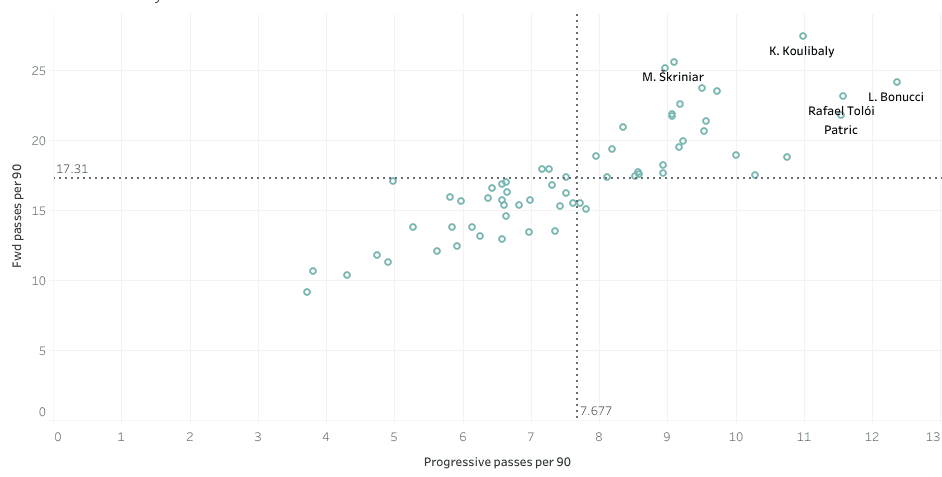
Nobody in the league, makes more forward passes per 90 than Koulibaly’s 31 per 90. He is followed by Škriniar (25.29) and Marlon (25.19) on the list. In terms of progressive passes per 90, Koulibaly (10.99) is only behind Leonardo Bonucci (12.36), Rafael Tolói (11.57) and Patric (11.55) on the list. His contributions in moving the ball forward have often caused the opposition quite a bit of trouble, while unlocking the opposition shape. This indicates Koulibaly’s willingness to play a pass in the game, and the forward intent with which the ball is played. Below are some instances where Koulibaly’s forward and long passing has contributed immensely to Napoli’s attack and build-up tactics.
The first instance for the analysis, is from the game Napoli vs Lazio. Koulibaly has at least four safe passing options, but instead opts to play a long attacking passes, to unlock Lazio’s shape. This long attacking pass adds a great deal of intent to Napoli’s build-up tactics. Below are the images to support the analysis.
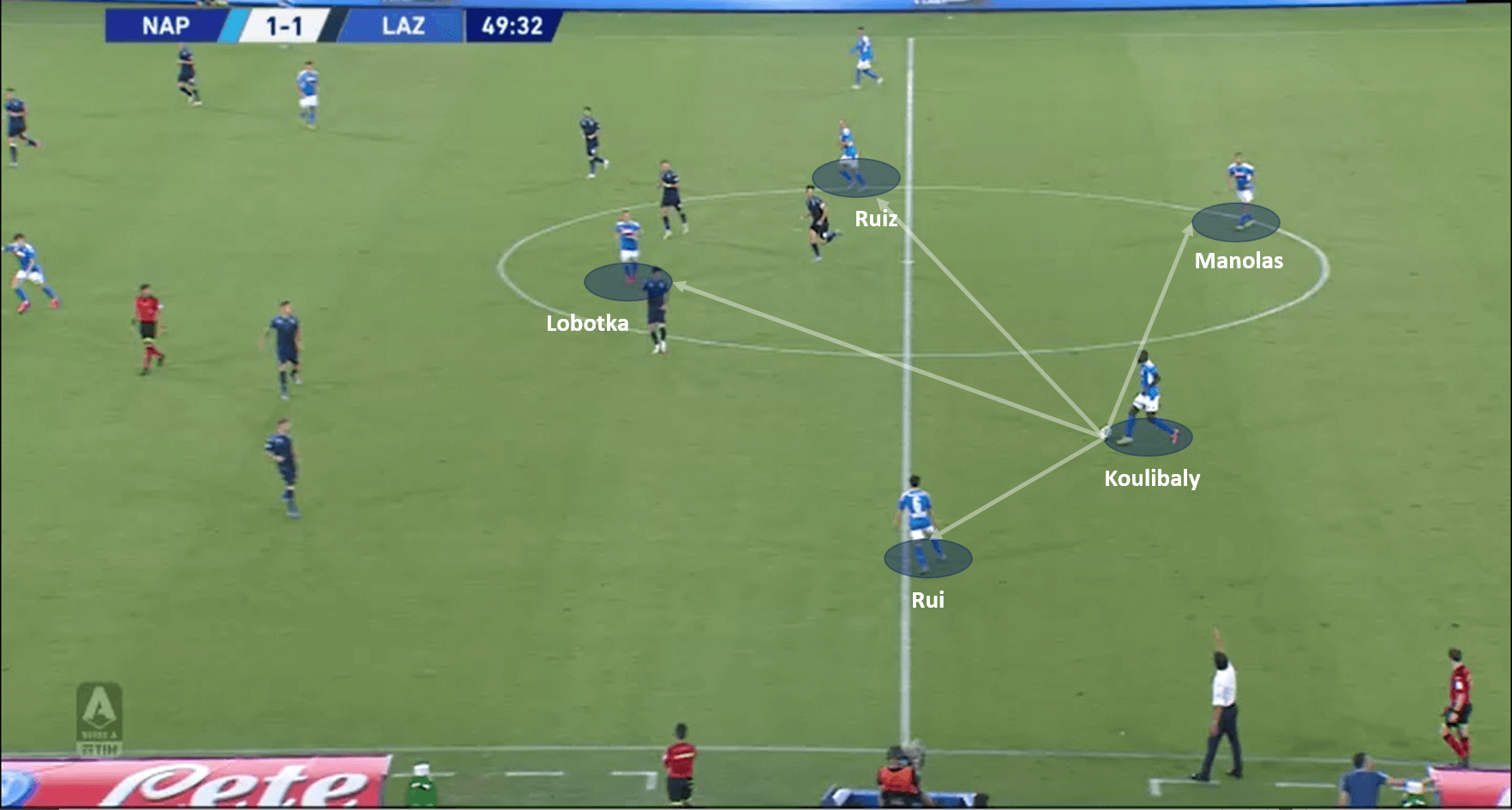
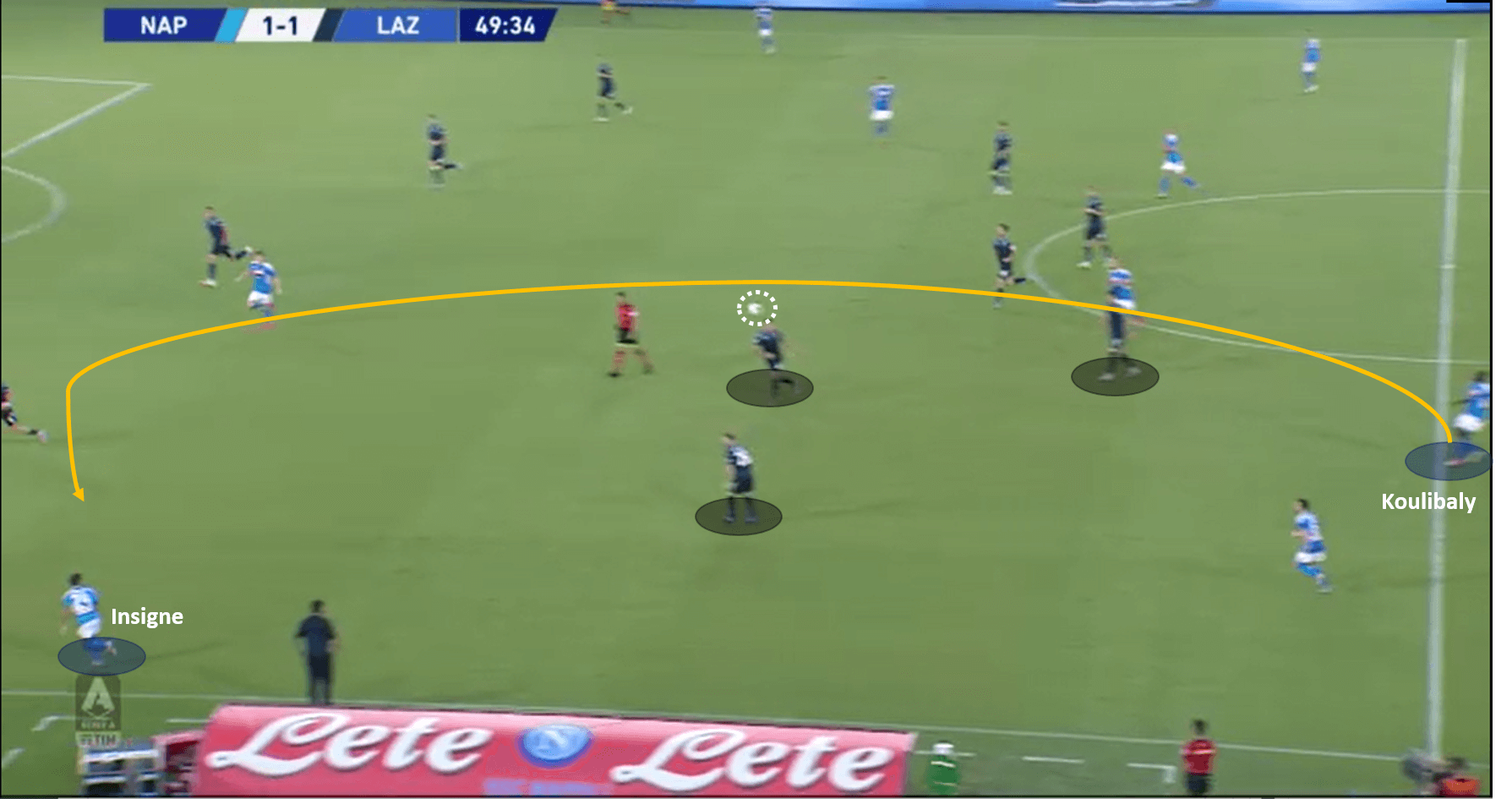
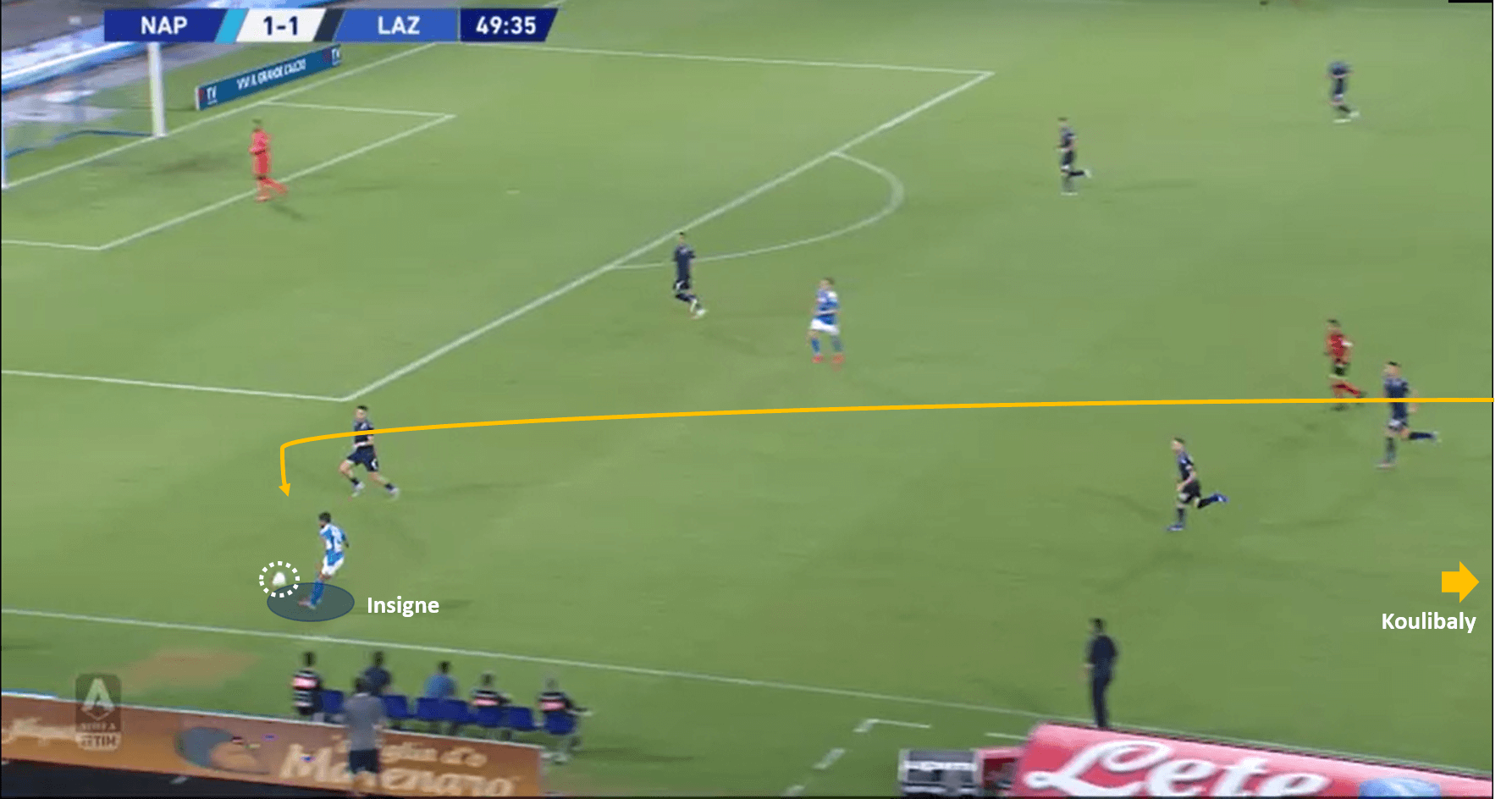
Another such instance to support the analysis, came in the same game when Koulibaly created an attack out of nothing to contribute to Napoli’s attacking tactics. Koulibaly had three safe passing options, and Napoli were leading the 2-1 into injury time. Where most defenders would prefer to kill the game by wasting time, Koulibaly had other ideas. Instead of opting for the easier passes, or time-wasting techniques, he launched an attack from the back trying to utilize Lozano’s pace. Lozano was caught offside by a thin margin however, but the vision by Koulibaly was spectacular. The images below support the analysis.
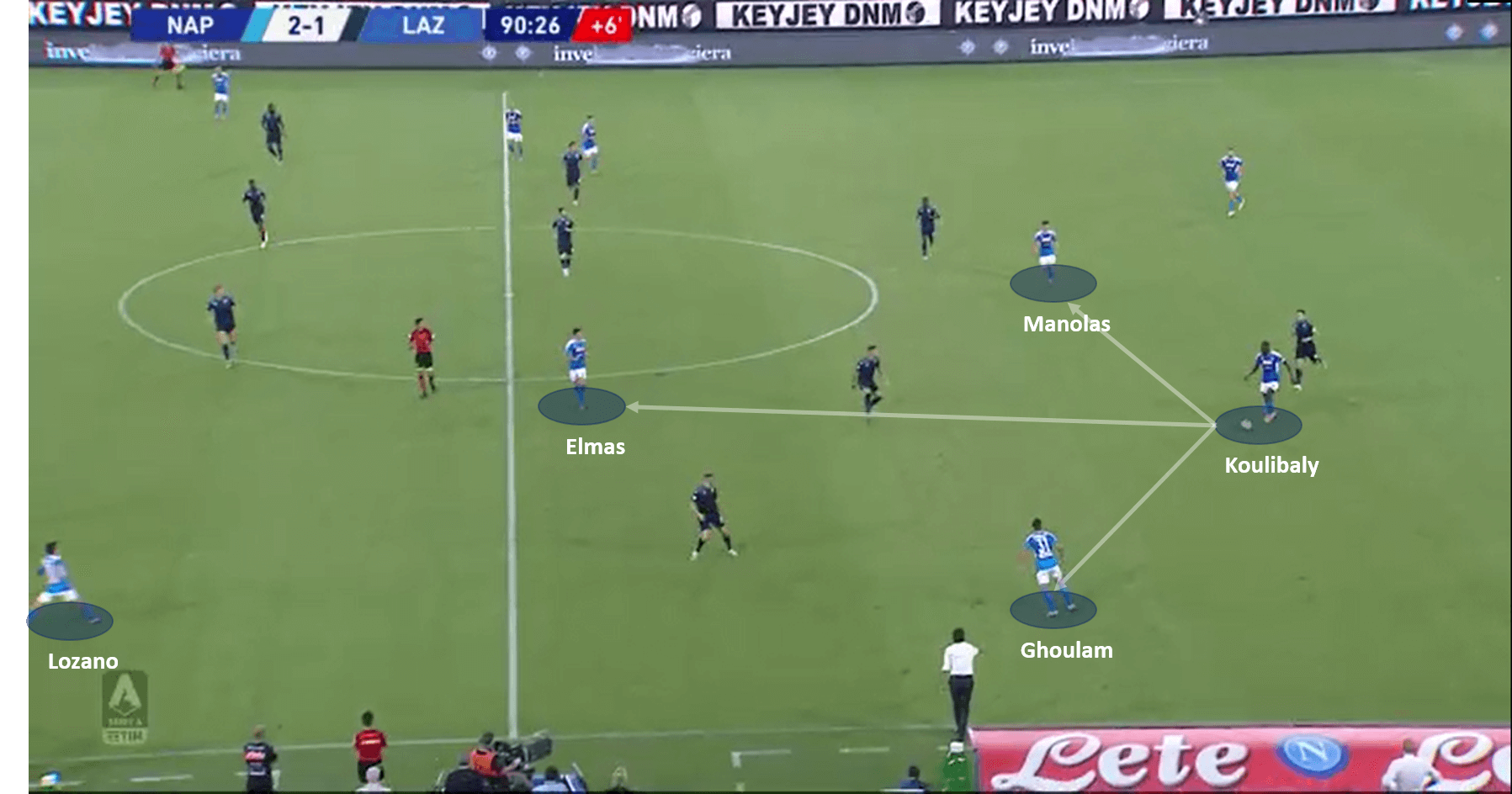
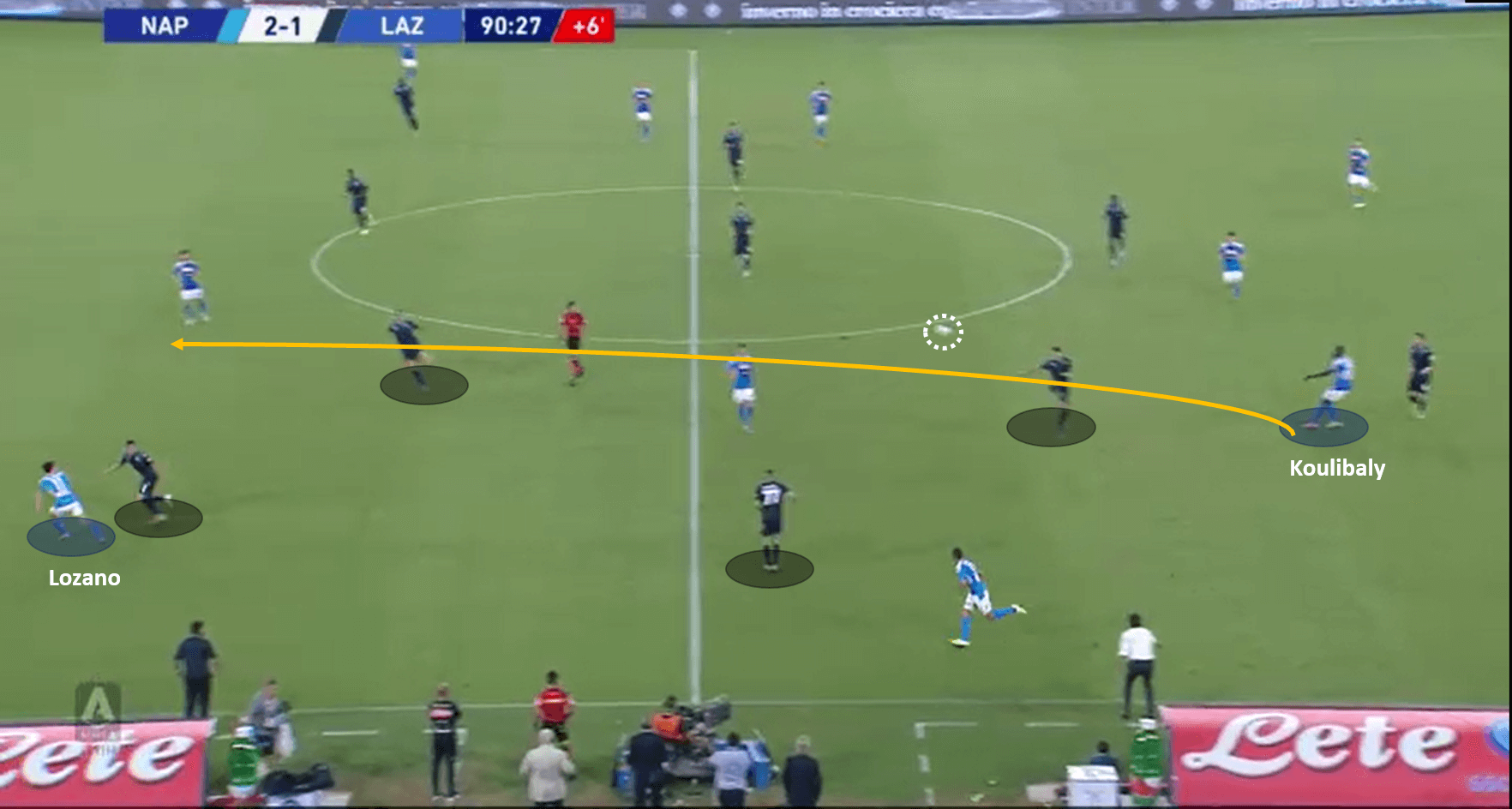
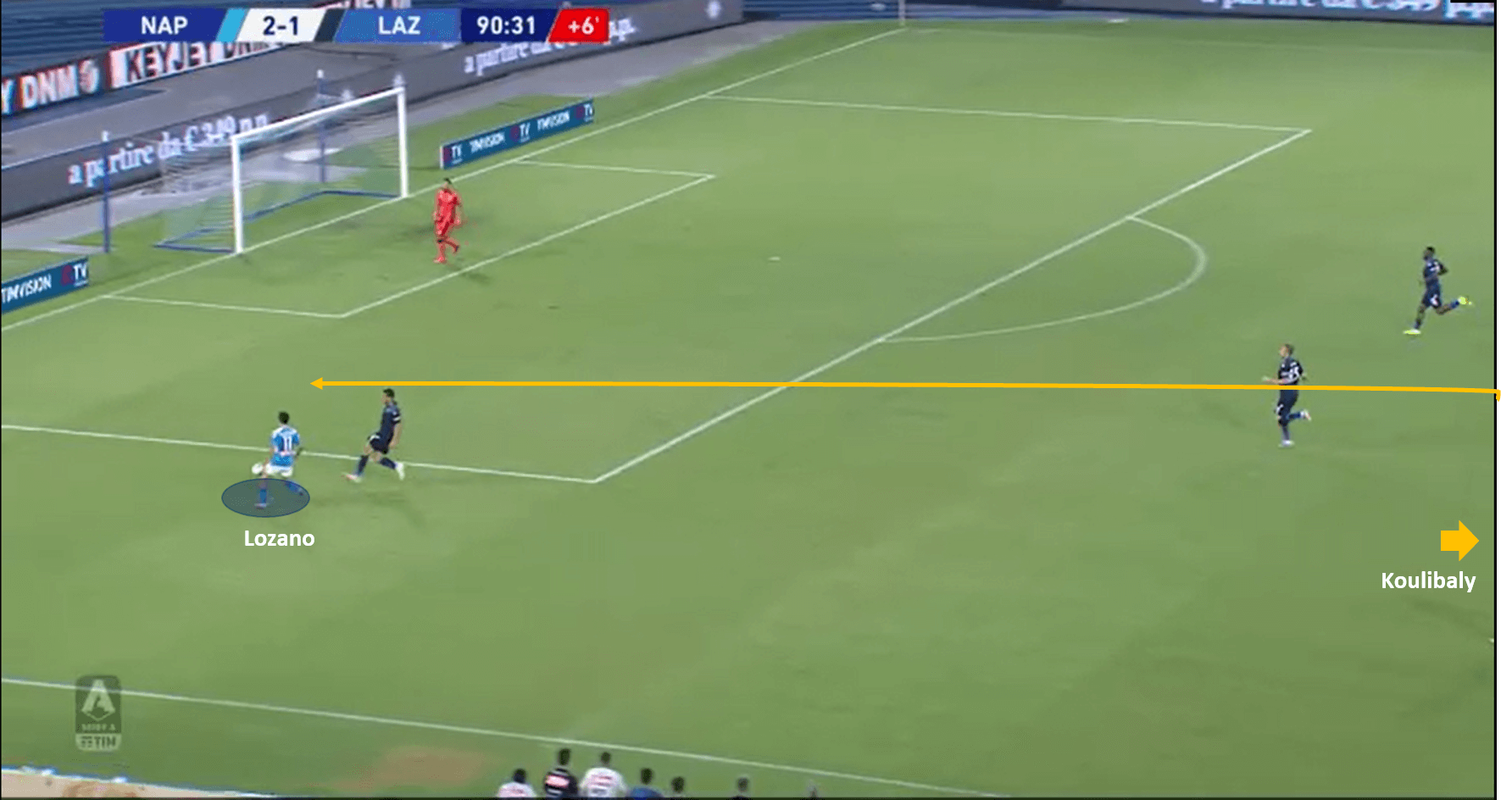
To support the analysis further, a similar instance is recorded from the game Lecce vs Napoli. Inside the first 30 seconds, Koulibaly kick-starts an attack with his long passing. His vision again on display, and re-emphasizing how crucial he is to Napoli’s tactics. He has at least three short passing options, but opts to play an attacking pass to catch the opposition off-guard. The below images support the analysis.
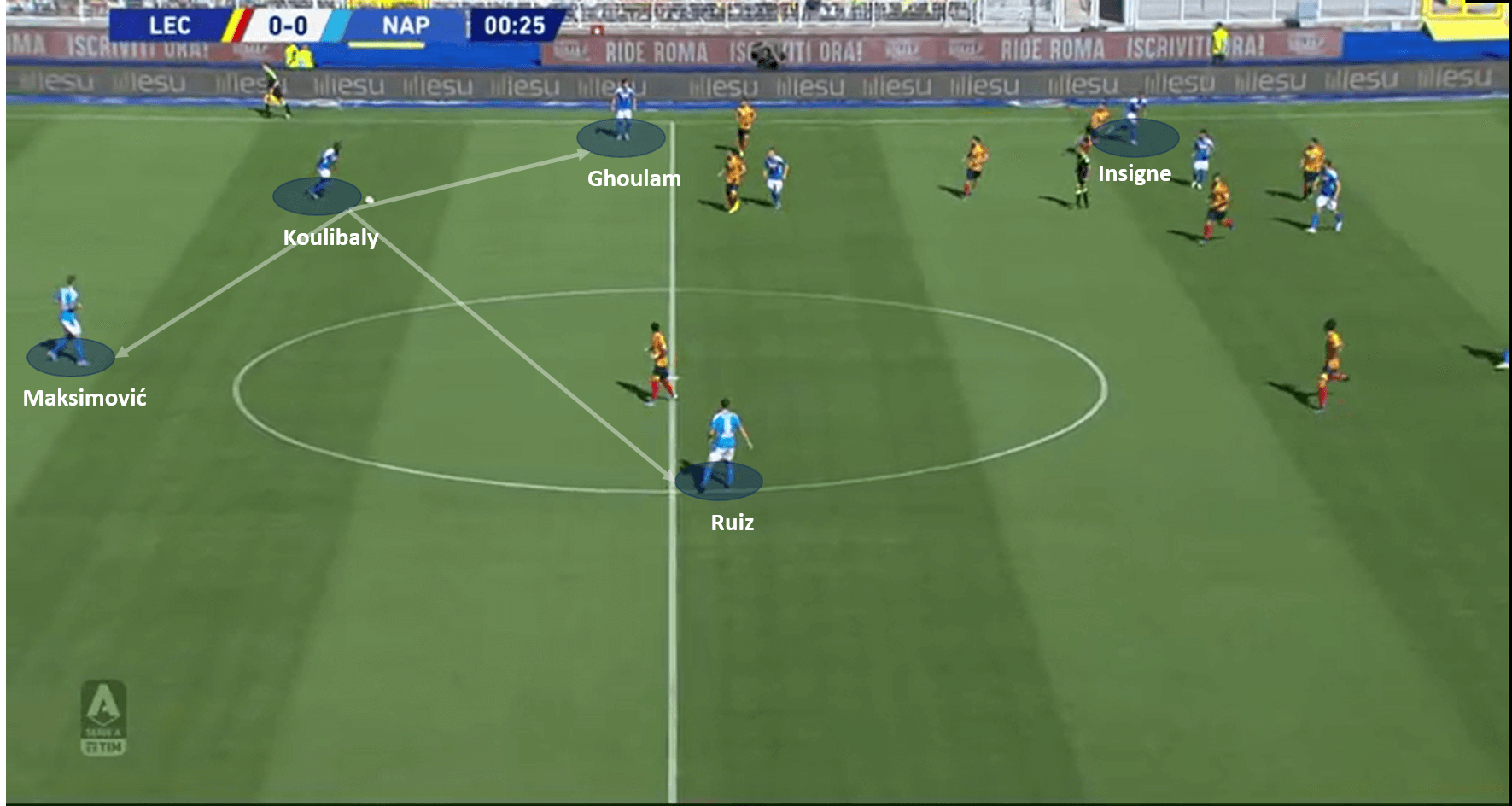
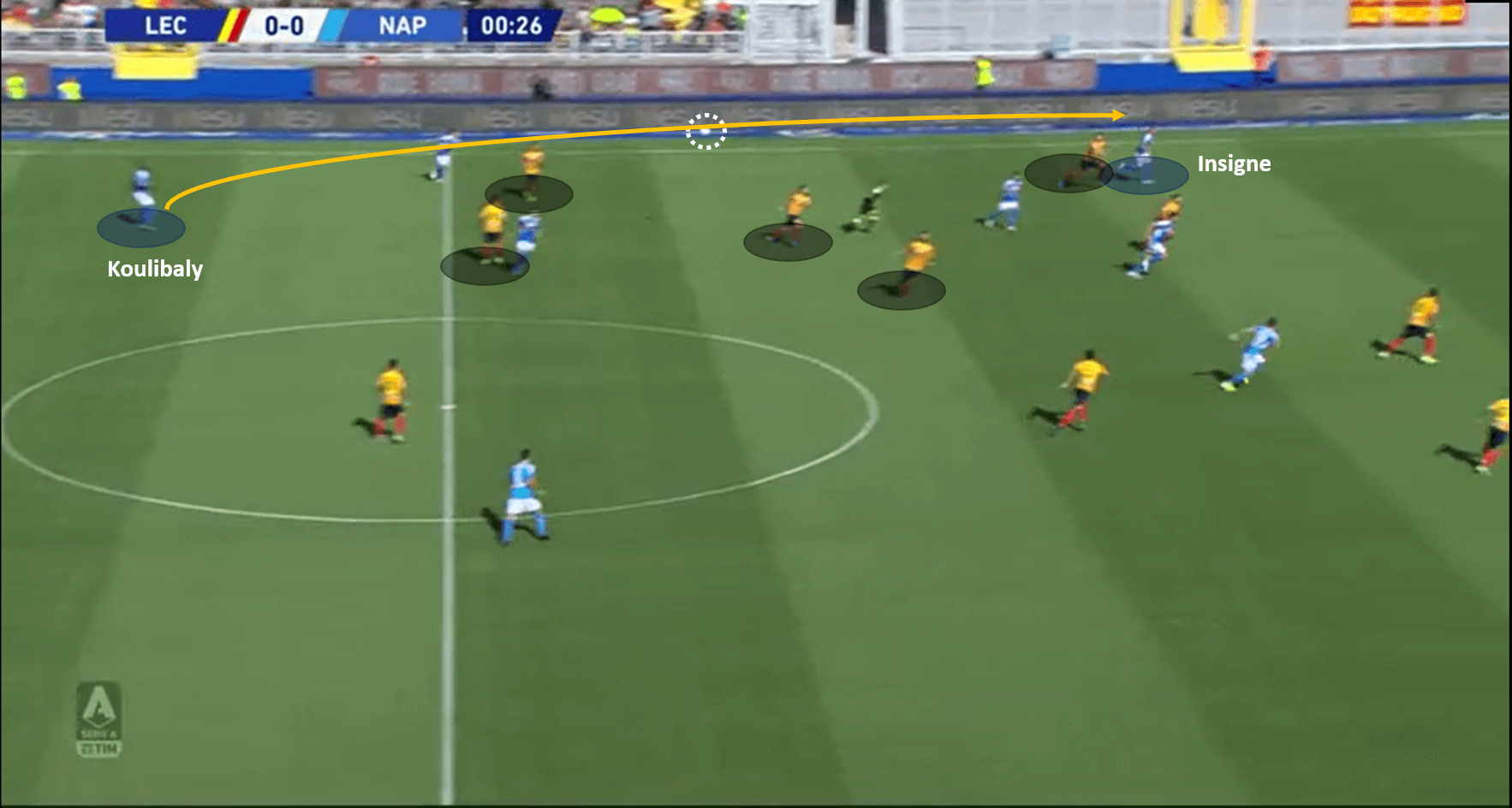
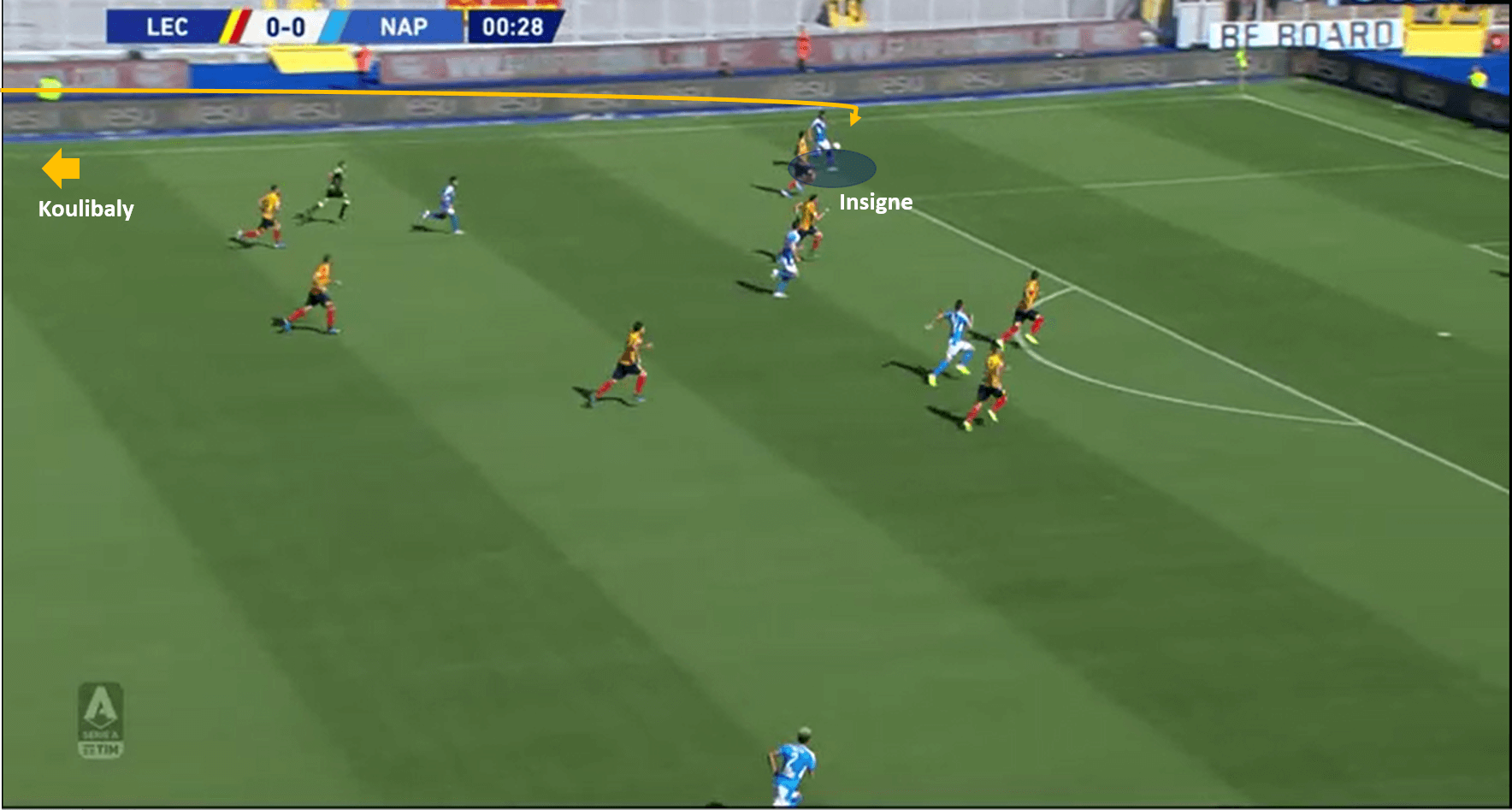
Conclusion – his importance to Napoli
While the scout report cannot conclusively state that Koulibaly is better than all of the other Napoli midfielders, it has provided an insight into the style of play adopted by Koulibaly. Defensively, there may be better options out there, but in terms of ball playing ability, there’s hardly any better in the league – no less the Napoli squad.
The tactical analysis, having covered two crucial aspects of Koulibaly’s play – defensive ability and ball playing ability, indicates that while there may be better options defensively, there are few better at ball playing ability than Koulibaly in the world. The scout report takes a look at a few instances where we’ve seen Koulibaly’s superior vision and long passing ability. His ability to play such passes has been key to Napoli’s tactics and the tactical analysis in this scout report further corroborates his importance in the line-up. Defensively however, Koulibaly tends to get less involved in the game, and needs to be teamed up with a more defensive minded central defender to balance the line.
If Napoli ever do have a question regarding his importance to their tactics and line-up, it wouldn’t take long to see what he brings to the team. An absolute must to have in the side, they must do everything they can to retain his services. Koulibaly has been linked to a host of clubs in the current transfer window as well, and if Napoli are to stand a chance to challenge for honours, Koulibaly is a must retain.






Comments